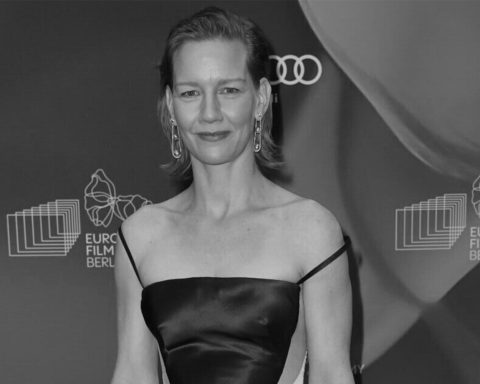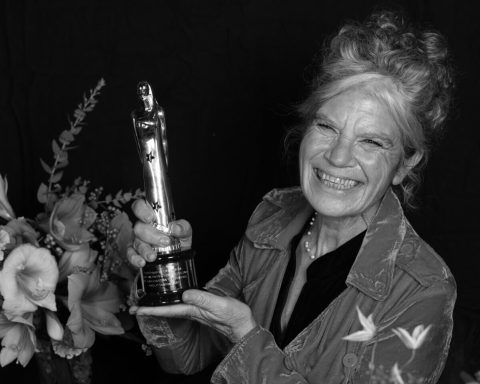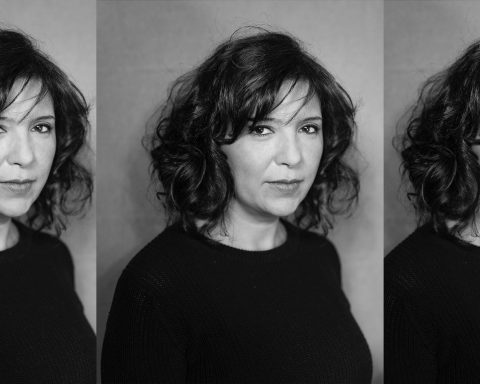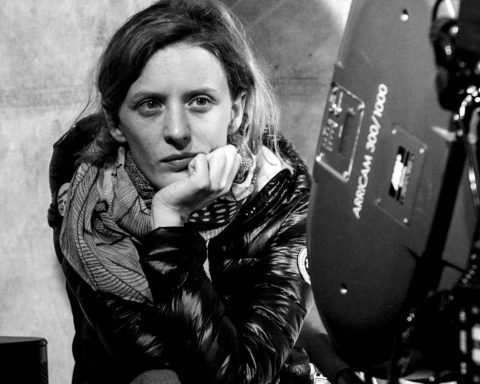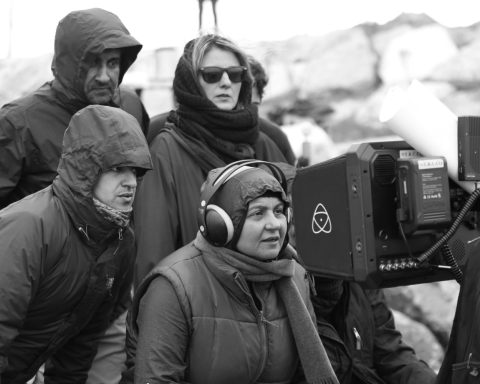Malene Choi was adopted from South Korea and grew up in Denmark. In 2005, she graduated from the National Film School of Denmark with her short film “Inshallah,” which received an Honorary Mention at the Hot Docs Canadian International Documentary Festival in 2006. In 2013, her short film “Creature” won the Robert Award for Best Danish Short Film. In 2018, her debut feature, the hybrid docudrama “The Return,” received a Special Mention at the International Film Festival Rotterdam and the Göteborg Film Festival.
Tara Karajica talks to Malene Choi about film and feminism and her latest feature, “The Quiet Migration,” a surreal meditation on transracial adoption in which a Korean adoptee, raised in the pastures of rural Denmark, struggles with identity. The film premiered at the 2023 Berlinale and is now screening in the Europe! Voices of Women in Film program at this year’s Sydney Film Festival.
How did you get into filmmaking?
Malene Choi: When I was a child, I saw black and white films by Tarkovsky and Bergman on the TV and was blown away by their seriousness and the way they dealt with big issues – life and death – and I wanted to become a filmmaker, but my parents said it was only for insiders, for people who had relatives working in the film industry that could get a job. Because I come from a working-class background, I thought that it was out of my reach. But after high school, I started studying Architecture and got more confident about my artistic ideas, but quit in order to pursue my dream of being a filmmaker and storyteller. I attended the European Film College, learnt about film and made an experimental short film. I then got into The National Film School of Denmark and was educated as a documentarian. All I wanted was to understand what life was about – its meaning and its purpose.
How did The Quiet Migration come about?
M.C.: Life was a mystery to me at the time I entered the film industry, without knowing to the fullest who I was and where I came from. I started returning to South Korea, my country of origin, and stayed at a guesthouse for adoptees only in Seoul. During several years, I met adoptees from around the world that shared their stories and, in my head, all their voices became a collective history of transnational adoptees. A pool of destinies. And, I started bringing them to life through filmmaking. The Return, my previous, film was about the first journey back to where you once came from, searching for your roots. What struck me was the many stories from young male adoptees who told me about their struggles of being an Asian man in a Western context, not being able to live up to the expectations of masculinity and beauty standards in their new adoptive families’ countries – Australia, USA, France, Germany, Sweden and Denmark. So, when I started writing The Quiet Migration, I wanted to depict a body out of place, feeling alienated, but also too well-adjusted, assimilated into a white society.
Not only is The Quiet Migration a coming-of-age story, but it also explores notions of otherness and (not)belonging, of a dual identity crisis of sorts, a pull of two worlds. Can you elaborate on that?
M.C.: What does it do to a human being not having access to their own history, not knowing from where or whom they come from at a time when the adoptive parents pick up the adoptive baby at the airport and had no knowledge of what country it arrived from? So, this lack of knowledge of a past, and a bodily longing for food served in small bowls, a landscape with more mountains, another temperature and another language were key for me to incorporate in the story because I have always felt that diffuse longing. When you don’t talk much about your birth country and birth family in the new family, you feel like your past is a taboo topic and then, you carry your loss alone. So, the difficult forming of kinship in an adoptive family was one of the main themes in the film and I had never seen another film deal with it before – maybe because you don’t bite the hand that feeds you.
The daily routine (on the farm) is a very important element in the film. Can you comment on that?
M.C.: Thematically, the film is about displacement and having a body out of place and by using the scale of heavy cows and huge tractors, the protagonist’s physicality is minor, lesser and shorter than the world. So, the human scale is smaller than the industrialized scale of a modern farm. At the same time, I use my documentary background to observe what life on a farm is like today; it’s hard work, but the connection to other creatures and nature is also giving, healing and a backdrop to what’s most iconic Danish – its flat landscape with wheat fields, dairy farms and blue sky. I use the daily routine on the farm to depict Carl’s life as authentically as possible in 90 minutes in order to transcend the fictious framework of the film because in my films there’s a hybridity of what is real and what is made up so as to get the audience to feel they are meeting a real person and getting to know a slice of his life.
Through inexplicable events and apparitions, you blur the line between the discernible outside world and the inner emotional world of the protagonist who is always daydreaming and escaping into his own head. Can you expand on that aspect of the film?
M.C.: Throughout my life, I have tried to live a normal life in the outside world, but have always had a need to disappear in my own thoughts, imaginations and daydreams. In the film, Carl lives the same way, with blurred lines between his inner and outer world, wondering about what could have been, filling out the gaps in his memory with imaginary thoughts and people. I guess that’s what you’re left with when you don’t know much about your identity.
Can you delve deeper into the family dynamics, where there is definitely love and good intentions, but at the same time secrets and a lack of communication?
M.C.: How you are tied together as a family if you don’t look like each other is a complex social process to shape a multicultural and multi-ethnic family, something that Carl’s adoptive parents aren’t much aware of; all they wanted was a child of their own, that had a resemblance to them. I have talked to several adoptees about their upbringing in their adoptive families and many have felt that they had to hide parts of their opinions and thoughts in order not to threaten the new kinship because you’re supposed to be grateful for your new life in a wealthier country, protected by the whiteness of your parents. Back in the day, my parents were advised by the Danish adoption agency not to talk so much about my past because it was just a topic that could make me sad and I was their child now and I should have the upbringing of a Danish child. So, the authorities also had the wrong conception of transnational adoption and the child’s rights and needs. So, I wanted to portray the family as what I believe is the most normal adoptive family, loving caring parents with good intentions, but with secrets of maybe wanting to have their own child more or suffering from the loss of a stillborn baby or not being able to conceive. In consideration, you can do much harm, and likewise, the adoptee won’t talk about racist comments to his/her parents because he/she doesn’t want to make them sad and stand out as a special problem.
You opt for a subtle, low-key approach, infused with compassion when conveying The Quiet Migration’s story. Can you comment on that?
M.C.: I wanted to mirror real life as I know it. It’s not a big drama. Life on a farm is not a dramatic plot, but the daily work is repetitive and in the evenings you’re tired of the hard physical work. And, because I come from a documentary background, I find other things interesting like the colour of the wallpaper, the porcelain figure, the light from the aquarium, etc. Part of human behaviour is also shaped by its environment and by looking at Carl’s surroundings, you can see what outer world he senses.
How much of your own experience is there in the script and the characters?
M.C.: In the transnational adoption trilogy I’m making, I draw from personal experiences half to a quarter of the story. Mostly, I know the feeling and the mood in every scene, but not always the actual drama or other characters. I know about being an only child in a family where the parents are old, and spending a lot of time drifting around alone on my own with my own thoughts and fantasies. Longing for something unknown and feeling the loss of something also unknown.
What were the challenges of making this particular film? And, the little victories?
M.C.: We shot the film between two COVID lockdowns in the rural part of Denmark and there were still some guidelines to be followed and we were quite nervous whether we could get a business visa to South Korea and not having to quarantine for fourteen days before three shooting days in Seoul. The small victories were the good and sunny whether on set; it’s not always like that in Denmark in September. And, our finding the main location just before we started shooting; we got an empty house that was up for sale and could dress it as we liked in terms of production design.
Can you talk about the title, “The Quiet Migration,” whose original version is “Stille Liv”?
M.C.: It’s called “The Quiet Migration” because we came alone as very young babies or children and we didn’t have a voice to consent to what was about to happen to us.
Are you a feminist? If so, how does it inform your filmmaking?
M.C.: I’m a feminist and I try to write female characters as nuanced as I know them to be from real life and give them a prominent place in my films. A lot of the suffering in the world comes from the violation of women’s rights. As a young woman, I worked in Angola as a volunteer at a children’s home and discovered how women and children were at the bottom of the society and somehow in the near future I would like to do a documentary about this issue, where girls do not have the rights over their own bodies to decide when and whom to have sexual intercourse with, but it is some male relatives who decides it. It breaks my heart how women are treated in some places in the world.
Do you have a favorite female filmmaker and a favorite film by a female filmmaker?
M.C.: I’m currently inspired by Alice Diop (Saint Omer), Charlotte Wells (Aftersun) and Chloé Zhao (The Rider). They are all filmmakers that got into fiction features from another background and there’s a documentary feeling in their films, it feels so real and the way they’re told suits the stories, which are not told according to the script formula that mainstream films often follow.
What is your opinion on the situation of women in film today? How is it in Denmark now?
M.C.: I think that it’s still difficult for women to break into the film industry, especially with fiction feature films, because so few of them are supported annually by the Danish Film Institute and you’re up against big players like Trier, Bier and Vinterberg. It all comes down to the intellect and filmic sensibility of two film commissioners that are employed for a four-year period. Back in the day, the DFI funded mostly films with a good plot and well-known characters, so more visually poetic stories and arthouse films couldn’t find their way through the jungle of financing. I cross my fingers that some of the female directors that have just had a break-through continue to write and make films on their own terms because there’s so much quality there.
What are your next projects?
M.C.: My next film is the last film in my trilogy about transnational adoption and it’s about peeling off your identity and dissolving into nature. It’s about moving back to South Korea, trying to be a Korean and being part of a newly found birth mother’s new family and getting to know her before she dies, while the adoptive Danish father is also struggling with his health after his wife’s death. Stuck between different families’ expectations of her, parts of the protagonist disappear while she is in nature. I might use the title “Loss of Love.”
Photo credits: Courtesy of Malene Choi.
This interview was conducted in partnership with:

and







